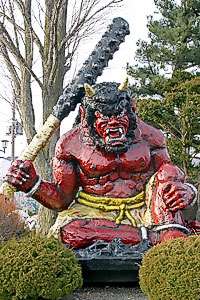Kanabō

The kanabō (金棒) was a spiked/knobbed club or truncheon used in feudal Japan as a weapon by samurai and their retainers. Other related weapons of this type are the nyoibo, konsaibo,[1][2] tetsubō (鉄棒), and the ararebo.[3] Related solid iron weapons with no spikes or knobs are the kanemuchi (kanamuchi) and the aribo (gojo/kirikobo).[4]
Description
Kanabō and the other related types of these club-like weapons were constructed out of heavy wood, or made entirely from iron, with iron spikes or studs on one end. One or both ends of the wooden type clubs could be sheathed in iron. Kanabō type weapons came in all sizes and shapes with the largest ones being as tall as a man and a two-handed weapon while the smaller lighter ones were primarily one-handed and the length of a forearm. The shape could be that of a baseball bat with a thick heavy end tapering towards a slender handle or they could be straight all the way from the handle to the end, with the shaft being round or multi faceted.[5][6][7]
Mythology
The kanabō was also a mythical weapon, often used in tales by oni (Japanese demon) since they were reputedly extremely strong.[8][9] Today there is a saying in Japanese: "Like giving a kanabō to an oni"—which means to give an extra advantage to someone who already has the advantage (the strong made stronger).[10] A western rendering might be "like adding fuel to a fire".
Use
It has been said that one purpose of the kanabō type of weapons was to smash enemies' armor, bones and the legs of their warhorses.[11] The art of using this cumbersome weapon, kanabō-jutsu or tetsubo-jutsu,[12][13] consisted of a mastery of both balance and strength; it required great skill to recover from a miss with the heavy club, which could leave a wielder open to a counter-attack.
See also
Gallery
-
Kanabo
-
Close up picture of the iron spikes of a kanabo-tetsubo.
-

Japanese kanabo.
-

Small antique Japanese wood club with iron covered ends and iron studs ararebo.[1]
-
Old Japanese wood club with iron spikes, kanabo or tetsubo, 4'9" tall and 4 lb in weight.
-
A small tetsubo.
-
Close up picture of the iron studs on an antique Japanese ararebo, a small version of the kanabo.
- ^ Classical weaponry of Japan: special weapons and tactics of the ... - Page 91 Serge Mol - 2003
References
- ↑ Tuttle dictionary of the martial arts of Korea, China & Japan - Page 168 Daniel Kogan, Sun-Jin Kim - 1996
- ↑ Pauley's Guide - A Dictionary of Japanese Martial Arts and Culture - Page 90 Daniel C. Pauley - 2009
- ↑ Classical weaponry of Japan: special weapons and tactics of the ... - Page 91 Serge Mol - 2003
- ↑ Classical weaponry of Japan: special weapons and tactics of the martial arts, Serge Mol, Kodansha International, Jun 17, 2003, P.106
- ↑ Secrets of the samurai: a survey of the martial arts of feudal Japan By Oscar Ratti, Adele Westbrook p.305
- ↑ Mol Serge. Classical weaponry of Japan: special weapons and tactics of the martial arts. p. 91.
- ↑ Heroes of the Grand Pacification: Kuniyoshi's Taiheiki eiyū den, p. 184
- ↑ Tigers, Devils, and Fools: A Guide to Japanese Proverbs By Edward Trimnell p.115
- ↑ Ishibashi, Tanzan. The Oriental economist, Volume 43. p. 45.
- ↑ The netsuke handbook Reikichi Ueda p.175
- ↑ Advanced Stick Fighting - Page 50 Masaaki Hatsumi - 2005
- ↑ Kogan, Daniel, and Sun-Jin Kim (1996). Tuttle dictionary of the martial arts of Korea, China & Japan. page 277.
- ↑ Draeger, Donn F., and Robert W. Smith. Comprehensive Asian fighting arts. p. 83.
External links
 Media related to Samurai clubs and truncheons at Wikimedia Commons
Media related to Samurai clubs and truncheons at Wikimedia Commons
| ||||||||||||||||||||||||||||||||||||||||||||||||||||||||||||||||||||||||||
